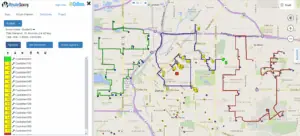Anyone running a fleet knows that meticulous management of fuel, labor, maintenance & technology all plays a crucial role in improving fleet financials.
A 2017 Government Fleet Magazine research study showed that 48% of all fleets increased in size since 2014. Obviously, as the number of vehicles per fleet increases, operating costs will correspondingly increase.
There are many ways to hold the line on rising operating costs for fleets, thus improving fleet finanancials.
In RouteSavvy’s December blogs, we’re going to focus on this important management function (watching the budget), and highlight how route planning software plays a critical role in helping fleets reduce or maintain operating costs.
In advance of our focus on fleet financials, here are some interesting statistics of how the money tends to be spent on most fleets.
Fuel Spend: Fuel prices have drastically fluctuated from 2008-20014. 2008 diesel prices were $4.70 per gallon and dropped to roughly $2 per gallon by spring of 2009. Prices rose again in 2010, and 2011, dropped in 2014, and increased by 2016.
According to the American Transportation Research Institute, fuel prices are still the biggest operating expense for fleets of all sizes. (This is why efficient routing can have such a profoundly positive effect when the goal is improving fleet financials.
Driver Pay: This is another area where labor costs for drivers continue to rise. The American Trucking Association estimated a shortage of 48,000 drivers in 2015, with the shortage of trained drivers reaching a whopping 175,000 by 2025. As this shortage of drivers increases, and as a result of federal Hours-of-Service rules for drivers (for safety), driver wages are increasing. When route planning software helps reduce overtime pay for drivers, this also can have a significant effect on improving fleet financials.
Visit the RouteSavvy blog in December for more detailed information on route planning software’s role in improving fleet financials. Or check out our Free Trial of RouteSavvy.




